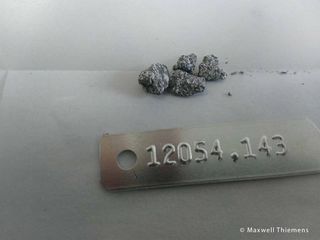The Moon Is 100 Million Years Older Than We Thought, Apollo Rocks Show

A new study of Apollo lunar rocks suggests that the moon is older than anyone believed.
The moon, researchers now say, likely formed about 50 million years after the solar system did, which is much earlier than the previous estimate of 150 million years after solar-system formation. A German-led group ferreted out the new estimate by studying three rare elements.
The traditional scientific origin story of the moon goes like this: The solar system arose about 4.56 billion years ago from a cloud of gas and dust in our cosmic neighborhood. Then, early in Earth's history, a Mars-size object careened into our planet. The invader got smashed to bits and took out a big chunk of our planet with it. This collision formed a huge debris cloud around Earth that over eons coalesced into our moon.
Related: How the Moon Evolved: A Photo Timeline

The newly theorized lunar age of 4.51 billion years, however, came after the team reanalyzed samples brought back by Apollo astronauts around 50 years ago. Such studies have happened many times before, but as instruments improve with advancing technology, it's possible for experts to make more-sensitive measurements of the rocks.
The scientists behind the new research zeroed in on the magma ocean that covered the moon shortly after the natural satellite formed; over time, this ocean cooled into the darker basalt regions still visible on the moon today. The researchers measured characteristics of three rare elements within this material: hafnium, uranium and tungsten.
These three elements act like a sort of cosmic clock because they are radioactive and decay into other elements at a predictable rate. Scientists can base analyses on how long it takes for half of a sample of a radioactive element to decay, the element's half-life, and calculate the age of rocks. This process works on any rocky body: Earth, the moon, Mars and the like.
Get the Space.com Newsletter
Breaking space news, the latest updates on rocket launches, skywatching events and more!
Related: How NASA's Apollo Astronauts Went to the Moon
"By comparing the relative amounts of different elements in rocks that formed at different times, it is possible to learn how each sample is related to the lunar interior and the solidification of the magma ocean," Raúl Fonseca, a co-author on the new research and a geochemist at the University of Cologne in Germany, said in a statement.
On the moon, an isotope called hafnium-182 decayed over time to produce an isotope known as tungsten-182. This decay was particularly swift, as it took place for only the first 70 million years of the solar system's history, according to the university statement. New studies of the Apollo rocks, paired with fresh laboratory experiments, thus suggested that the moon started to solidify only 50 million years after the solar system formed.
"This age information means that any giant impact had to occur before that time, which answers a fiercely debated question amongst the scientific community regarding when the moon formed," senior author Carsten Münker, a professor of geochemistry and cosmochemistry at the University of Cologne, said in the statement.
A study based on the research was published on Monday (July 29) in the journal Nature Geoscience.
- How the Moon Formed: 5 Wild Lunar Theories
- How the Moon Was Made: Lunar Evolution Explained (Infographic)
- NASA Fed Apollo 11 Moon Rocks to Cockroaches (and Then Things Got Even Weirder)
Follow Elizabeth Howell on Twitter @howellspace. Follow us on Twitter @Spacedotcom and on Facebook.
Join our Space Forums to keep talking space on the latest missions, night sky and more! And if you have a news tip, correction or comment, let us know at: community@space.com.

Elizabeth Howell (she/her), Ph.D., is a staff writer in the spaceflight channel since 2022 covering diversity, education and gaming as well. She was contributing writer for Space.com for 10 years before joining full-time. Elizabeth's reporting includes multiple exclusives with the White House and Office of the Vice-President of the United States, an exclusive conversation with aspiring space tourist (and NSYNC bassist) Lance Bass, speaking several times with the International Space Station, witnessing five human spaceflight launches on two continents, flying parabolic, working inside a spacesuit, and participating in a simulated Mars mission. Her latest book, "Why Am I Taller?", is co-written with astronaut Dave Williams. Elizabeth holds a Ph.D. and M.Sc. in Space Studies from the University of North Dakota, a Bachelor of Journalism from Canada's Carleton University and a Bachelor of History from Canada's Athabasca University. Elizabeth is also a post-secondary instructor in communications and science at several institutions since 2015; her experience includes developing and teaching an astronomy course at Canada's Algonquin College (with Indigenous content as well) to more than 1,000 students since 2020. Elizabeth first got interested in space after watching the movie Apollo 13 in 1996, and still wants to be an astronaut someday. Mastodon: https://qoto.org/@howellspace
Most Popular

